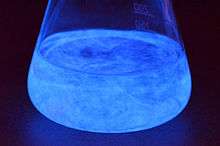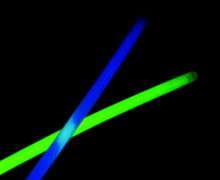Chemiluminescence
Chemiluminescence (also chemoluminescence) is the emission of light (luminescence), as the result of a chemical reaction. There may also be limited emission of heat. Given reactants A and B, with an excited intermediate ◊,
- [A] + [B] → [◊] → [Products] + light

For example, if [A] is luminol and [B] is hydrogen peroxide in the presence of a suitable catalyst we have:
where:
- 3-APA is 3-aminophthalate
- 3-APA[◊] is the vibronic excited state fluorescing as it decays to a lower energy level.
General description
The decay of this excited state[◊] to a lower energy level causes light emission.[1] In theory, one photon of light should be given off for each molecule of reactant. This is equivalent to Avogadro's number of photons per mole of reactant. In actual practice, non-enzymatic reactions seldom exceed 1% QC, quantum efficiency.
In a chemical reaction, reactants collide to form a transition state, the enthalpic maximum in a reaction coordinate diagram, which proceeds to the product. Normally, reactants form products of lesser chemical energy. The difference in energy between reactants and products, represented as , is turned into heat, physically realized as excitations in the vibrational state of the normal modes of the product. Since vibrational energy is generally much greater than the thermal agitation, it rapidly disperses in the solvent through molecular rotation. This is how exothermic reactions make their solutions hotter. In a chemiluminescent reaction, the direct product of the reaction is an excited electronic state. This state then decays into an electronic ground state and emits light through either an allowed transition (analogous to fluorescence) or a forbidden transition (analogous to phosphorescence), depending partly on the spin state of the electronic excited state formed.
Chemiluminescence differs from fluorescence or phosphorescence in that the electronic excited state is the product of a chemical reaction rather than of the absorption of a photon. It is the antithesis of a photochemical reaction, in which light is used to drive an endothermic chemical reaction. Here, light is generated from a chemically exothermic reaction. The chemiluminescence might be also induced by an electrochemical stimulus, in this case is called electrochemiluminescence.
_mating.gif)
A standard example of chemiluminescence in the laboratory setting is the luminol test. Here, blood is indicated by luminescence upon contact with iron in hemoglobin. When chemiluminescence takes place in living organisms, the phenomenon is called bioluminescence. A light stick emits light by chemiluminescence.
Liquid-phase reactions
Chemiluminescence in aqueous system is mainly caused by redox reactions.[2]

- Luminol in an alkaline solution with hydrogen peroxide in the presence of iron or copper,[3] or an auxiliary oxidant,[4] produces chemiluminescence. The luminol reaction is
Gas-phase reactions

- One of the oldest known chemiluminescent reactions is that of elemental white phosphorus oxidizing in moist air, producing a green glow. This is a gas-phase reaction of phosphorus vapor, above the solid, with oxygen producing the excited states (PO)2 and HPO.[5]
- Another gas phase reaction is the basis of nitric oxide detection in commercial analytic instruments applied to environmental air-quality testing. Ozone is combined with nitric oxide to form nitrogen dioxide in an activated state.
- NO+O3 → NO2[◊]+ O2
- The activated NO2[◊] luminesces broadband visible to infrared light as it reverts to a lower energy state. A photomultiplier and associated electronics counts the photons that are proportional to the amount of NO present. To determine the amount of nitrogen dioxide, NO2, in a sample (containing no NO) it must first be converted to nitric oxide, NO, by passing the sample through a converter before the above ozone activation reaction is applied. The ozone reaction produces a photon count proportional to NO that is proportional to NO2 before it was converted to NO. In the case of a mixed sample that contains both NO and NO2, the above reaction yields the amount of NO and NO2 combined in the air sample, assuming that the sample is passed through the converter. If the mixed sample is not passed through the converter, the ozone reaction produces activated NO2[◊] only in proportion to the NO in the sample. The NO2 in the sample is not activated by the ozone reaction. Though unactivated NO2 is present with the activated NO2[◊], photons are emitted only by the activated species that is proportional to original NO. Final step: Subtract NO from (NO + NO2) to yield NO2[6]
Infrared chemiluminescence
In chemical kinetics, infrared chemiluminiscence (IRCL) refers to the emission of infrared photons from vibrationally excited product molecules immediately after their formation. The intensities of infrared emission lines from vibrationally excited molecules are used to measure the populations of vibrational states of product molecules.[7][8]
The observation of IRCL was developed as a kinetic technique by John Polanyi, who used it to study the attractive or repulsive nature of the potential energy surface for gas-phase reactions. In general the IRCL is much more intense for reactions with an attractive surface, indicating that this type of surface leads to energy deposition in vibrational excitation. In contrast reactions with a repulsive potential energy surface lead to little IRCL, indicating that the energy is primarily deposited as translational energy.[9]
Enhanced chemiluminescence
Enhanced chemiluminescence is a common technique for a variety of detection assays in biology. A horseradish peroxidase enzyme (HRP) is tethered to an antibody that specifically recognizes the molecule of interest. This enzyme complex then catalyzes the conversion of the enhanced chemiluminescent substrate into a sensitized reagent in the vicinity of the molecule of interest, which on further oxidation by hydrogen peroxide, produces a triplet (excited) carbonyl, which emits light when it decays to the singlet carbonyl. Enhanced chemiluminescence allows detection of minute quantities of a biomolecule. Proteins can be detected down to femtomole quantities,[10][11] well below the detection limit for most assay systems.
Applications
- Gas analysis: for determining small amounts of impurities or poisons in air. Other compounds can also be determined by this method (ozone, N-oxides, S-compounds). A typical example is NO determination with detection limits down to 1 ppb. Highly specialised chemiluminescence detectors have been used recently to determine concentrations as well as fluxes of NOx with detection limits as low as 5 ppt.[12][13][14]
- Analysis of inorganic species in liquid phase
- Analysis of organic species: useful with enzymes, where the substrate is not directly involved in the chemiluminescence reaction, but the product is
- Detection and assay of biomolecules in systems such as ELISA and Western blots
- DNA sequencing using pyrosequencing
- Lighting objects. Chemiluminescence kites,[15] emergency lighting, glow sticks[16] (party decorations).
- Combustion analysis: Certain radical species (such as CH* and OH*) give off radiation at specific wavelengths. The heat release rate is calculated by measuring the amount of light radiated from a flame at those wavelengths.[17]
- Children's toys.
- Glow sticks.
Biological applications
Chemiluminescence has been applied by forensic scientists to solve crimes. In this case, they use luminol and hydrogen peroxide. The iron from the blood acts as a catalyst and reacts with the luminol and hydrogen peroxide to produce blue light for about 30 seconds. Because only a small amount of iron is required for chemiluminescence, trace amounts of blood are sufficient.
In biomedical research, the protein that gives fireflies their glow and its co-factor, luciferin, are used to produce red light through the consumption of ATP. This reaction is used in many applications, including the effectiveness of cancer drugs that choke off a tumor's blood supply. This form of bioluminescence imaging allows scientists to test drugs in the pre-clinical stages cheaply. Another protein, aequorin, found in certain jellyfish, produces blue light in the presence of calcium. It can be used in molecular biology to assess calcium levels in cells. What these biological reactions have in common is their use of adenosine triphosphate (ATP) as an energy source. Though the structure of the molecules that produce luminescence is different for each species, they are given the generic name of luciferin. Firefly luciferin can be oxidized to produce an excited complex. Once it falls back down to a ground state a photon is released. It is very similar to the reaction with luminol.
Many organisms have evolved to produce light in a range of colors. At the molecular level, the difference in color arises from the degree of conjugation of the molecule, when an electron drops down from the excited state to the ground state. Deep sea organisms have evolved to produce light to lure and catch prey, as camouflage, or to attract others. Some bacteria even use bioluminescence to communicate. The common colors for the light emitted by these animals are blue and green because they have shorter wavelength than red and can transmit more easily in water.
Chemiluminescence is different from fluorescence. Hence the application of fluorescent proteins such as Green fluorescent protein is not a biological application of chemiluminescence.
References
- Vacher, Morgane; Fdez. Galván, Ignacio; Ding, Bo-Wen; Schramm, Stefan; Berraud-Pache, Romain; Naumov, Panče; Ferré, Nicolas; Liu, Ya-Jun; Navizet, Isabelle; Roca-Sanjuán, Daniel; Baader, Wilhelm J.; Lindh, Roland (March 2018). "Chemi- and Bioluminescence of Cyclic Peroxides". Chemical Reviews. 118 (15): 6927–6974. doi:10.1021/acs.chemrev.7b00649. PMID 29493234.
- Shah, Syed Niaz Ali; Lin, Jin-Ming (2017). "Recent advances in chemiluminescence based on carbonaceous dots". Advances in Colloid and Interface Science. 241: 24–36. doi:10.1016/j.cis.2017.01.003. PMID 28139217.
- "Luminol chemistry laboratory demonstration". Retrieved 2006-03-29.
- "Investigating luminol" (PDF). Salters Advanced Chemistry. Archived from the original (PDF) on September 20, 2004. Retrieved 2006-03-29.
- Rauhut, Michael M. (1985), Chemiluminescence. In Grayson, Martin (Ed) (1985). Kirk-Othmer Concise Encyclopedia of Chemical Technology (3rd ed), pp 247 John Wiley and Sons. ISBN 0-471-51700-3
- Air Zoom | Glowing with Pride Archived 2014-06-12 at the Wayback Machine. Fannation.com. Retrieved on 2011-11-22.
- Atkins P. and de Paula J. Physical Chemistry (8th ed., W.H.Freeman 2006) p.886 ISBN 0-7167-8759-8
- Steinfeld J.I., Francisco J.S. and Hase W.L. Chemical Kinetics and Dynamics (2nd ed., Prentice-Hall 1998) p.263 ISBN 0-13-737123-3
- Atkins P. and de Paula J. p.889-890
- Enhanced CL review. Biocompare.com (2007-06-04). Retrieved on 2011-11-22.
- High Intensity HRP-Chemiluminescence ELISA Substrate Archived 2016-04-08 at the Wayback Machine. Haemoscan.com (2016-02-11). Retrieved on 2016-03-29.
- "ECOPHYSICS CLD790SR2 NO/NO2 analyser" (PDF). Archived from the original (PDF) on 2016-03-04. Retrieved 2015-04-30.
- Stella, P., Kortner, M., Ammann, C., Foken, T., Meixner, F. X., and Trebs, I.: Measurements of nitrogen oxides and ozone fluxes by eddy covariance at a meadow: evidence for an internal leaf resistance to NO2, Biogeosciences, 10, 5997-6017, doi:10.5194/bg-10-5997-2013, 2013.
- Tsokankunku, Anywhere: Fluxes of the NO-O3-NO2 triad above a spruce forest canopy in south-eastern Germany. Bayreuth, 2014 . - XII, 184 P. ( Doctoral thesis, 2014, University of Bayreuth, Faculty of Biology, Chemistry and Earth Sciences)
- Kinn, John J "Chemiluminescent kite" U.S. Patent 4,715,564issued 12/29/1987
- Kuntzleman, Thomas Scott; Rohrer, Kristen; Schultz, Emeric (2012-06-12). "The Chemistry of Lightsticks: Demonstrations To Illustrate Chemical Processes". Journal of Chemical Education. 89 (7): 910–916. Bibcode:2012JChEd..89..910K. doi:10.1021/ed200328d. ISSN 0021-9584.
- Chemiluminescence as a Combustion Diagnostic Archived 2011-03-02 at the Wayback Machine Venkata Nori and Jerry Seitzman - AIAA - 2008